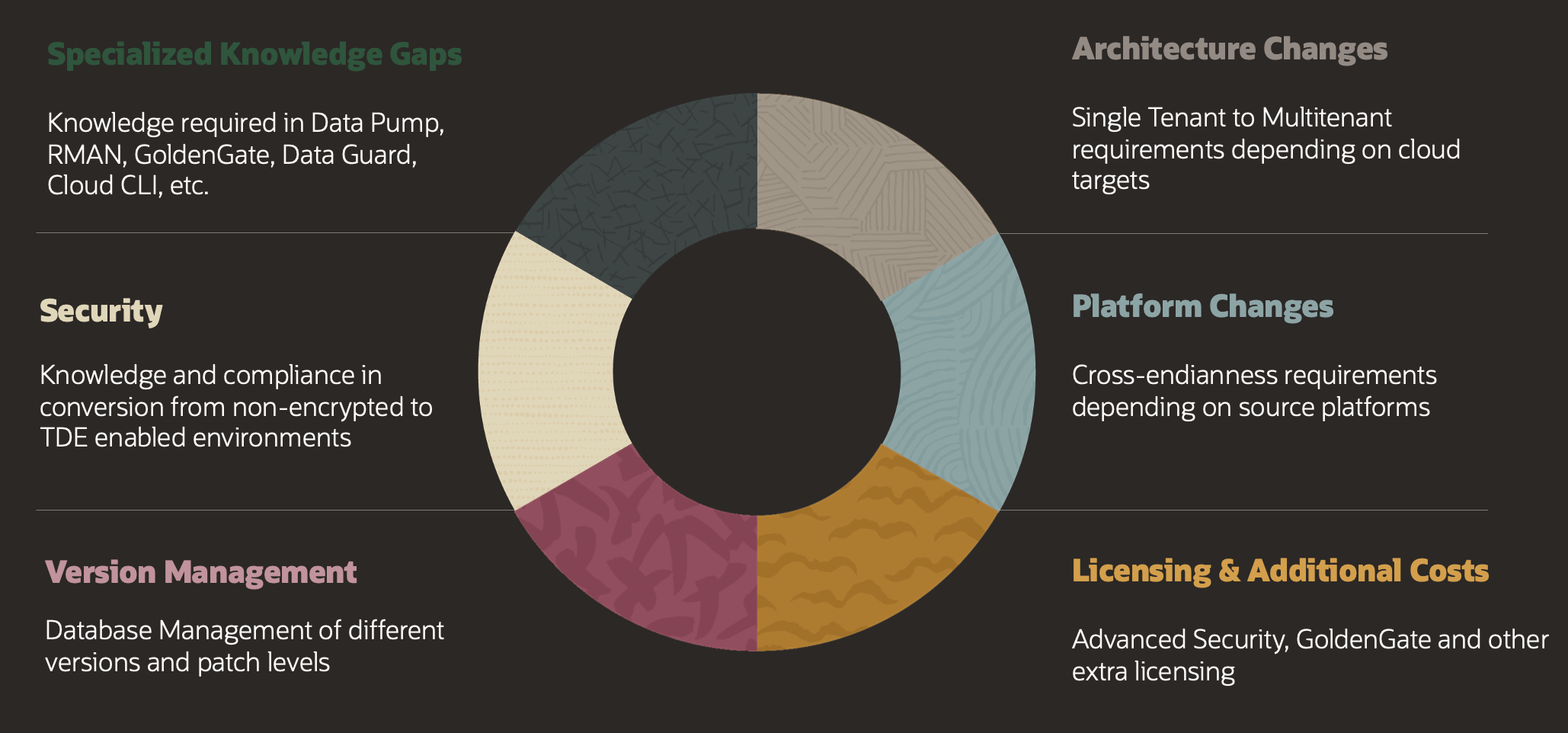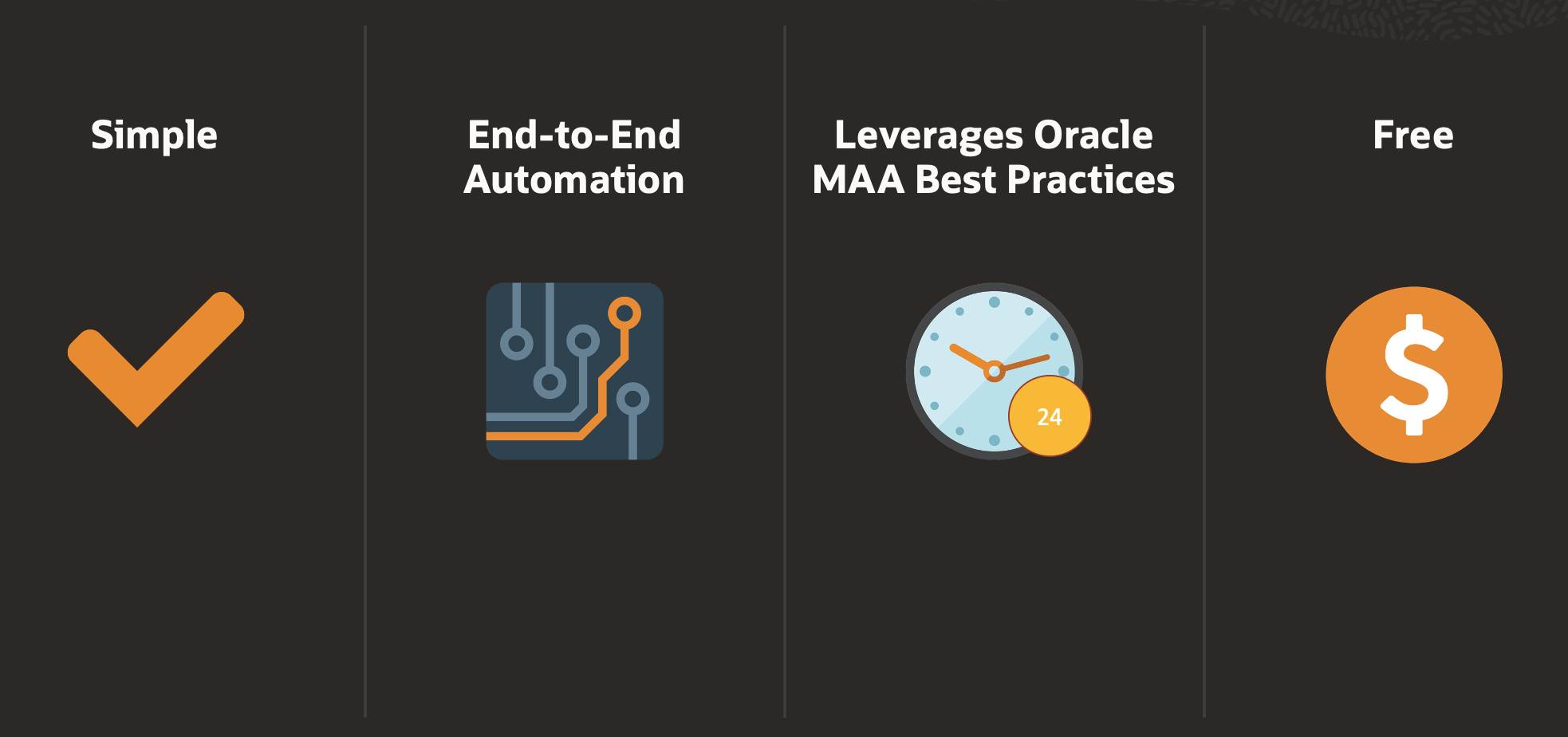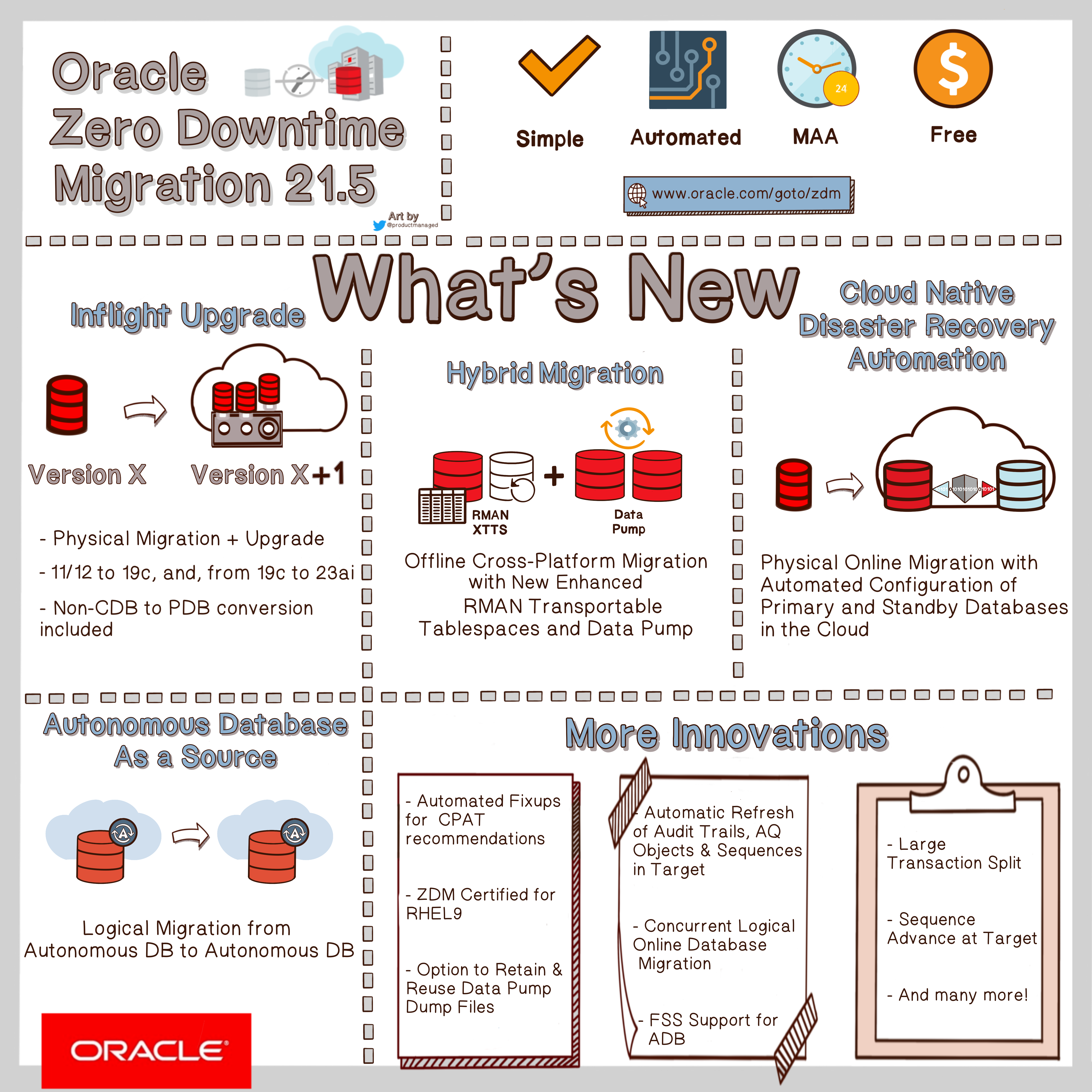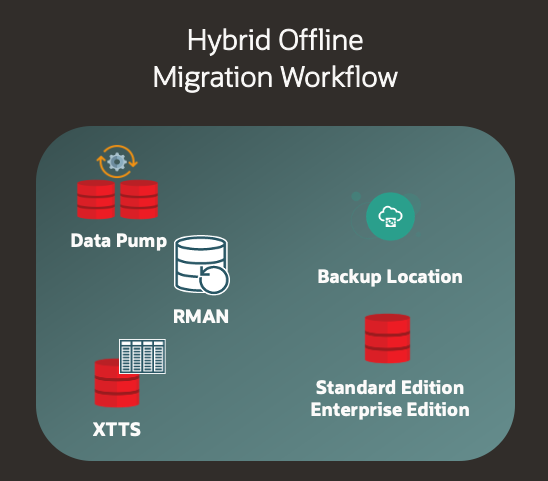I am pleased to announce the general availability of Oracle Zero Downtime Migration 21.5. ZDM is Oracle’s standard and leading solution for database migration to Oracle Cloud Infrastructure, Exadata Cloud@Customer, Exadata On-Premises, Oracle Database@Azure, Oracle Database@Google Cloud, and Oracle Database@AWS. Thousands of databases and customers have leveraged ZDM’s powerful automation for a straightforward, faster, and secure cloud migration journey.
ZDM leverages Oracle’s Maximum Availability Architecture (MAA) best practices, provides a robust end-to-end automation suite, and is free for all customers. Join me as I discuss the latest groundbreaking innovations in Oracle Database migration technology. But first, let’s discuss the different migration challenges you may face while embarking on your Cloud Migration journey.
Cloud Migration Challenges
Cloud migrations can pose different challenges and become a rather cumbersome journey. The following are only some of the challenges that customers face during their cloud migrations:
- Specialized Knowledge Gaps
- Teams of dedicated professionals with knowledge of products such as Data Pump, Recovery Manager (RMAN), Data Guard, GoldenGate, Cloud command line, and much more are required.
- Security
- In-depth knowledge of security and compliance for database deployments and expertise in implementing Transparent Data Encryption environments are needed.
- Version Management
- Database fleets comprise tens to hundreds of databases with different versions and patch levels, resulting in inventory management and target version challenges for migration projects.
- Architecture and Platform Changes
- Oracle Database has different configurations, ranging from a single instance to Oracle RAC, non-container to multitenant environments, and different endianness. Knowledge of how to convert between different architectures is required for migration projects.
- Licensing & Additional Costs
- Using products required for a migration project might require additional licensing, which could increase the budget.

Why Oracle Zero Downtime Migration (ZDM)?
Oracle ZDM tackles customers’ cloud migration challenges while providing the best-in-class automation following Oracle Maximum Availability Architecture best practices.
Simple
Oracle ZDM offers a single-button solution for your entire database cloud migration journey, simplifying the tasks required for manual migration. There is no need for specialized knowledge; ZDM handles all the aspects necessary for cloud migration, from setup configuration to security and task orchestration.
Automated
Oracle ZDM’s automation and orchestration take care of the migration process end-to-end in a certified, repeatable process of migrating your database fleet. Through testing and intensive vetting, customers found that ZDM’s automation results in time savings of up to 50% for planning and design and 30% for engineer hours for migration projects. Oracle ZDM’s automation handles all automatable aspects, from version management to patching, securing, and ensuring a swift migration to the Cloud.
Oracle MAA
ZDM is designed, developed, and tested by Oracle’s Maximum Availability Architecture development team. During this process, high availability and scalability best practices are engrained in ZDM’s core functionality, providing Oracle’s customers with the best migration solution for their Mission-Critical Oracle Databases independent of their deployment type, configuration, endianness or any other variable that affects the migration process. Oracle’s Maximum Availability Architecture Best Practices are in place to cover most use cases, thus providing the best possible migration experience.
Free
Oracle ZDM is free of additional charge. ZDM strives to provide Oracle customers with the best cloud journey possible by providing a comprehensive migration solution at no cost. Further, ZDM’s usage of other technologies, like the Advanced Security Option and Advanced Compression Option, has a specific provision under Oracle Database’s Restricted License. Finally, GoldenGate for migrations with ZDM has a special provision for a specific period as per the Cloud Marketplace listing licensing agreements.

What’s New in Oracle Zero Downtime Migration 21.5

Introducing a New Migration Workflow: Offline Hybrid Migration
For the first time since Oracle ZDM 21c, we are introducing a new migration workflow, Hybrid Migration. This new offline workflow leverages RMAN transportable tablespaces for data migration and Data Pump Import/Export for metadata. Hybrid Migration requires NFS to be configured as a backup location, allows for cross-endian and cross-version migration, and is supported for the following targets:
- Base DB
- ExaDB-D
- Exadata Cloud@Customer
- Exadata On-Premises

Hybrid Migration Step-by-Step
How does the new Hybrid Offline Migration workflow work? Let’s see a step-by-step overview of what this new feature entails:
- ZDM connects to the source, target
- ZDM Orchestrates Tablespace Level Backups
- Performs a full backup of the tablespaces
- Performs an incremental backup of the tablespaces
- Copies Wallet files as required
- ZDM performs a full restore of tablespaces as foreign tablespaces
- ZDM Sets Source tablespaces as Read Only and Performs Final Incremental Backup
- Performs an incremental backup of the tablespaces and metadata export of the tablespaces using RMAN
- Copies Wallet Files as required
- ZDM Exports Metadata via Data Pump
- Export includes:
- Metadata
- PL/SQL Objects
- Non-Tablespaces data
- Export includes:
- ZDM Imports Metadata and Performs an Incremental Restore
- 1st Import of user metadata from Data Pump
- 2nd Incremental restore with RMAN + import of tablespace metadata generated by RMAN
- 3rd import of all other metadata (objects and non-tablespace data)
- ZDM Performs Post Actions, Cleans up, and Finalizes
Physical Migration Innovations
Physical Migration has evolved from a backup/restore and Data Guard automation workflow to a robust, game-changing migration methodology. The following are some exciting enhancements and innovations introduced with Oracle ZDM 21.5.
Inflight Upgrade
Until today, ZDM’s physical migration workflow only allowed migrations between source and target databases of the same version. ZDM 21.5 introduces physical migration with an in-flight upgrade. This new feature will enable you to migrate your 11.2.0.4 and 12c Oracle Databases into 19c Oracle databases. It also supports migrations from 19c source databases to Oracle Database 23ai.
This feature helps CDB source databases by migrating and upgrading in-flight to a CDB target in the cloud. In contrast, for non-CDB source databases, ZDM offers extra help, maximizing the benefits of the overall migration process. ZDM will migrate and convert those databases to a pluggable database and upgrade them at the target level using a temporary target database of the same version as the source database. ZDM performs an initial migration to a temporary target and then leverages Oracle Cloud Infrastructure’s tooling to upgrade to the desired version of a new database in the cloud.
Cloud Native Disaster Recovery Automation
Primary-standby database configurations are a best practice of Oracle Maximum Availability Architecture. ZDM now supports physical migrations with Native Disaster Recovery Configuration in the cloud. ZDM 21.5 allows customers to migrate their Single Instance or Oracle RAC databases into the cloud while creating an associated standby database in the cloud as part of the migration workflow. This new feature provides customers with a Cloud-Native Disaster Recovery architecture.

Logical Migration Innovations
Introduced in ZDM 21c, Logical Migration expanded ZDM’s available workflows and provided customers with three key advantages: migration to autonomous databases, in-flight upgrade, and cross-endian migration. In ZDM 21.5, Logical Migration is further strengthened with new features and functionality. Let’s learn about each one of them below.
Autonomous Database as a Source
ZDM now supports migration from Oracle Autonomous databases into other Oracle Autonomous Databases. This new feature allows customers to migrate and move Autonomous Databases between tiers, shared or dedicated, and between regions.
GoldenGate Enhancements
- Replication Mode now supports integrated and non-integrated modes, allowing customers to choose GoldenGate’s mode versatility according to their specific migration use case. This feature enhances ZDM’s adoption of GoldenGate and, for customers with specific requirements like the need for integrated features, provides a more robust and comprehensive logical online migration experience.
- Audit Trail import is now enabled, with a specific parameter at the response file level.
- Large Transaction split support. Customers can now specify large transaction sizes via the response file; ZDM will then divide large transactions into pieces that will be applied in parallel by individual GoldenGate appliers, resulting in faster.
- Feature Groups are now supported via a response file parameter, allowing users to specify which procedural calls will be replicated (e.g., all_supported, AQ, FGA, DBFS, etc.)
- Constraint Handling is now optimized via DBOPTIOS DEFERREFCONST for the Oracle GoldenGate Replicat.
- Concurrent Migrations are now supported with the same Oracle GoldenGate deployment. Each job is allowed to the specific database wallet required for the migration, which can be used with both autonomous and non-autonomous targets.
- Pre-checks for ggadmin have been improved, and ZDM will notify users about missing privileges.
- GoldenGate Schema can now be user-specified and differ from the standard ggadmin.
Data Pump Enhancements
- Dump File retention and reuse, allowing customers to store exported data pump files and reuse them for future migrations if required.
- Advanced Queue objects are now supported for post-import reload if specified via the user’s response file.
Further Logical Migration Enhancements
- File Storage Service (FSS) is now supported as a data transfer medium for Autonomous Database targets.
- Materialized Views automated refresh post-import. This new feature is optional and can be enabled via a new response file parameter.
- Sequence Handling is now enhanced. ZDM will automatically advance sequences at the target level during the switchover phase, ensuring sequence matching with the source database.
Learn More
For more information on Oracle Zero Downtime Migration, technical briefs, and documentation, please visit:
